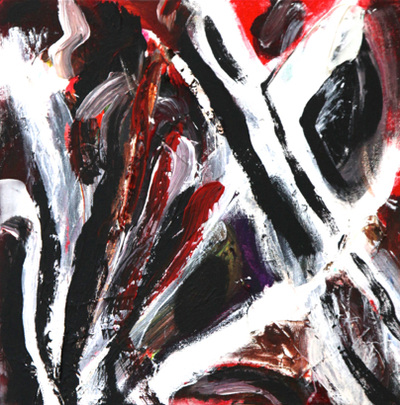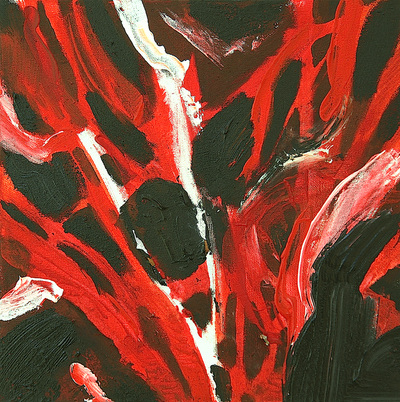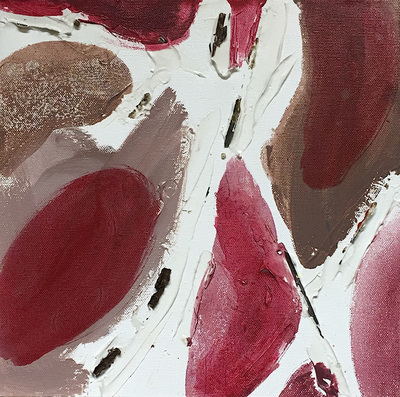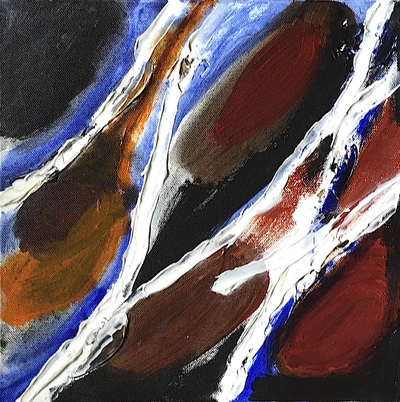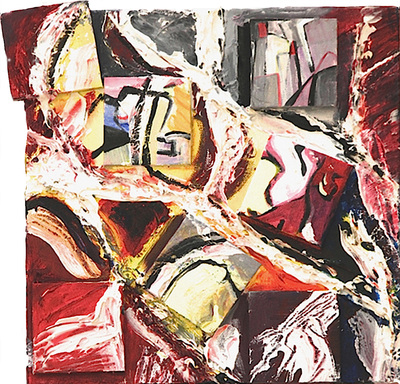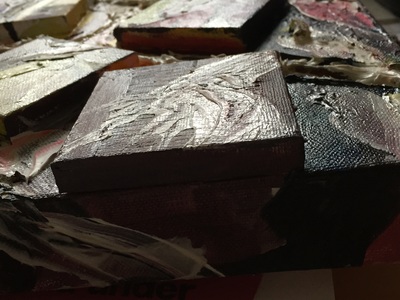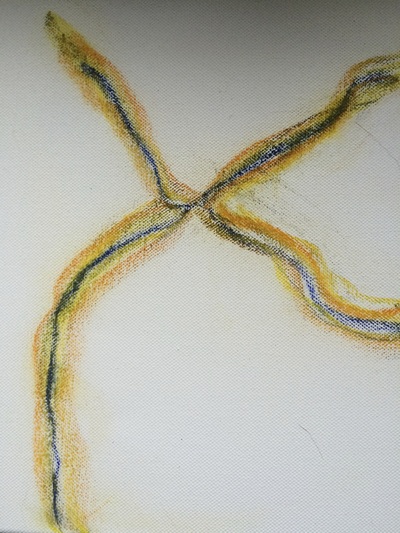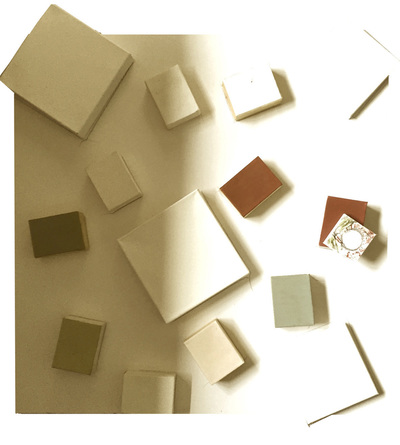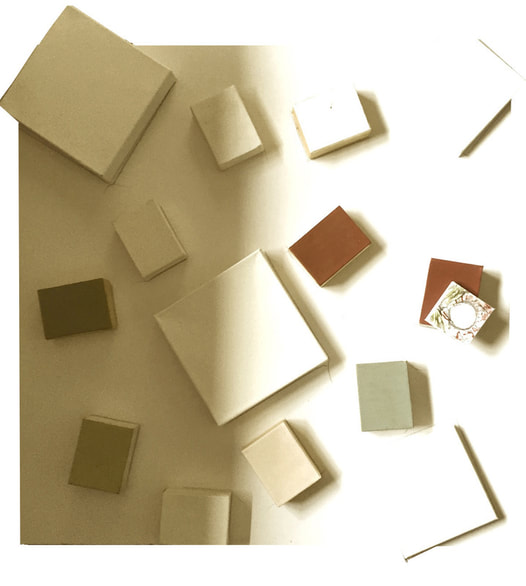Yvonne Jones: (Artist Researcher)
Internal Landscapes: Series 2 ( 2012 -2015 ), Images / Process / Context - a series of 6 developing work used in
Material Imagination Link Gallery 2015 and in
Internal landscapes (evolved) Installation CCI 2018
IMAGES
Developing Building canvas Work
PROCESS
These are individual works progressing. For this series of work Internal Landscapes (series 2) I allowed myself to let the work lead me. I became interested in twigs, on walks I would notice them and collect them. Eventually I needed to do something with these 'treasures'. I scaled my usual work size down, to small 12 X 12 inch canvases. The twigs were scattered, shuffled shaken, onto the canvas and left. When the structure satisfied, I glued them into the positions where they looked 'right'. Using acrylic paint I made marks, textures forms in and around (and over) the rib structure on the canvas. The structural twigs were removed, some bits remaining, like ghosts of the structure creating depths and spaces upon the canvas. I continued with this approach and method interjecting with non pre-structured pieces, small works on paper.
CONTEXT
Works were dotted around my studio. The first two amongst them, executed prior to the following event. I found a lump in my left breast and was duly examined and directed to day surgery, it was considered the odds were against it being serious. During the preparation a radiologist, at first dismissing what she saw, then acknowledging her instinct of concern about a second previously un noticed area, contacted the surgeon. An immediate new biopsy was taken for this new area. It was cancer. I underwent surgery to remove both areas and some lymph nodes. Radiotherapy to follow. Walking into my studio on the evening of the surgery, in a state of shock, (a cancer diagnosis is usually given two weeks before surgery for the patient to adapt and absorb the news, mine came and surgery undertaken in one day) the two 'inner landscapes' jumped out at me. Landscape 2 has two very black areas, areas I spent a great deal of time working on, taking my brush round and round on these areas and returning to them many times. Standing looking at my work I had the experience that I was looking into my breast and at the two removed area, at the cancer. Initially not knowing where my work was going I had the sense that my body had the knowledge of its disease and was 'speaking' it through my first language, visual art.
Following a seminar I led with PIRG Facing the Posthuman 24 March 2015 Bevis Fenner wrote :
'our sensory experience is once removed by the time we know it in a subjective sense. However, whatever the time delay in, for example, processing light and colour into subjective experience, as Noriko (Noriko Suzuki-Bosco 2015) suggests, knowing is a 'lived in' process of doing, sensing, making; we cannot understand our bodies until we have used them. In Hedeggerian terms, an embodied authenticity of being or Dasein, comes from knowing the body not as present-at-hand – a theoretical object of the subject in which any body is an interchangeable tool for the head – but as ready to hand or that which is already known. Noriko points us in the direction of Tim Ingold who suggests that ‘[t]o know things you have to grow into them, and let them grow in you, so that they become a part of who you are’ (Ingold, 2012: 1).' (Fenner 2015)
I suggest that here the experience of body was experienced through the art, delayed, not knowing the sensation from this 'blind' area of the body (Drew Leder) it became known through art expression.
While the works from Internal Landscapes 1 - 5 came out of experience of Breast Cancer and its treatment Internal Landscape 6 (series 2) Fragmented Memories of a Trauma 2014, followed on from the above process, building on this 'direction of flow', using small canvases, modeling paste and paint on a base canvas a new approach BUILT CANVAS. The cancer, by now controlled, was followed with a heart procedure, this IL6 is my experience of the heart surgery events. This work is also acting as a swing bridge between this series, and the works developing out of them.
I am interested to explore where canvas constructions can lead, whether such work can engage with video projection.
These are individual works progressing. For this series of work Internal Landscapes (series 2) I allowed myself to let the work lead me. I became interested in twigs, on walks I would notice them and collect them. Eventually I needed to do something with these 'treasures'. I scaled my usual work size down, to small 12 X 12 inch canvases. The twigs were scattered, shuffled shaken, onto the canvas and left. When the structure satisfied, I glued them into the positions where they looked 'right'. Using acrylic paint I made marks, textures forms in and around (and over) the rib structure on the canvas. The structural twigs were removed, some bits remaining, like ghosts of the structure creating depths and spaces upon the canvas. I continued with this approach and method interjecting with non pre-structured pieces, small works on paper.
CONTEXT
Works were dotted around my studio. The first two amongst them, executed prior to the following event. I found a lump in my left breast and was duly examined and directed to day surgery, it was considered the odds were against it being serious. During the preparation a radiologist, at first dismissing what she saw, then acknowledging her instinct of concern about a second previously un noticed area, contacted the surgeon. An immediate new biopsy was taken for this new area. It was cancer. I underwent surgery to remove both areas and some lymph nodes. Radiotherapy to follow. Walking into my studio on the evening of the surgery, in a state of shock, (a cancer diagnosis is usually given two weeks before surgery for the patient to adapt and absorb the news, mine came and surgery undertaken in one day) the two 'inner landscapes' jumped out at me. Landscape 2 has two very black areas, areas I spent a great deal of time working on, taking my brush round and round on these areas and returning to them many times. Standing looking at my work I had the experience that I was looking into my breast and at the two removed area, at the cancer. Initially not knowing where my work was going I had the sense that my body had the knowledge of its disease and was 'speaking' it through my first language, visual art.
Following a seminar I led with PIRG Facing the Posthuman 24 March 2015 Bevis Fenner wrote :
'our sensory experience is once removed by the time we know it in a subjective sense. However, whatever the time delay in, for example, processing light and colour into subjective experience, as Noriko (Noriko Suzuki-Bosco 2015) suggests, knowing is a 'lived in' process of doing, sensing, making; we cannot understand our bodies until we have used them. In Hedeggerian terms, an embodied authenticity of being or Dasein, comes from knowing the body not as present-at-hand – a theoretical object of the subject in which any body is an interchangeable tool for the head – but as ready to hand or that which is already known. Noriko points us in the direction of Tim Ingold who suggests that ‘[t]o know things you have to grow into them, and let them grow in you, so that they become a part of who you are’ (Ingold, 2012: 1).' (Fenner 2015)
I suggest that here the experience of body was experienced through the art, delayed, not knowing the sensation from this 'blind' area of the body (Drew Leder) it became known through art expression.
While the works from Internal Landscapes 1 - 5 came out of experience of Breast Cancer and its treatment Internal Landscape 6 (series 2) Fragmented Memories of a Trauma 2014, followed on from the above process, building on this 'direction of flow', using small canvases, modeling paste and paint on a base canvas a new approach BUILT CANVAS. The cancer, by now controlled, was followed with a heart procedure, this IL6 is my experience of the heart surgery events. This work is also acting as a swing bridge between this series, and the works developing out of them.
I am interested to explore where canvas constructions can lead, whether such work can engage with video projection.
